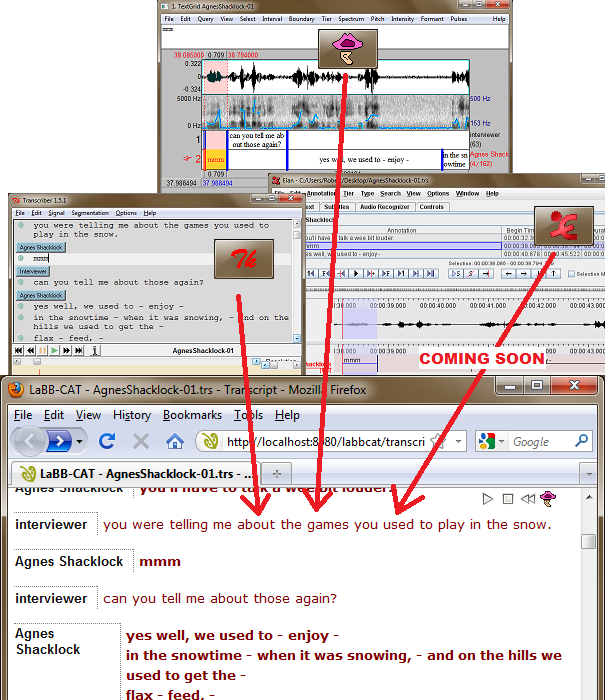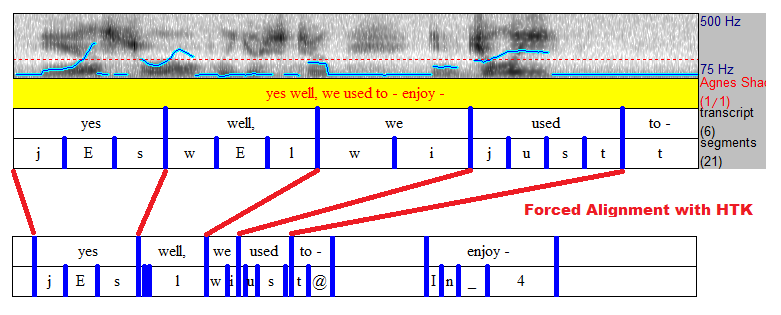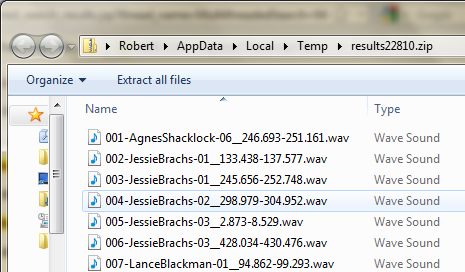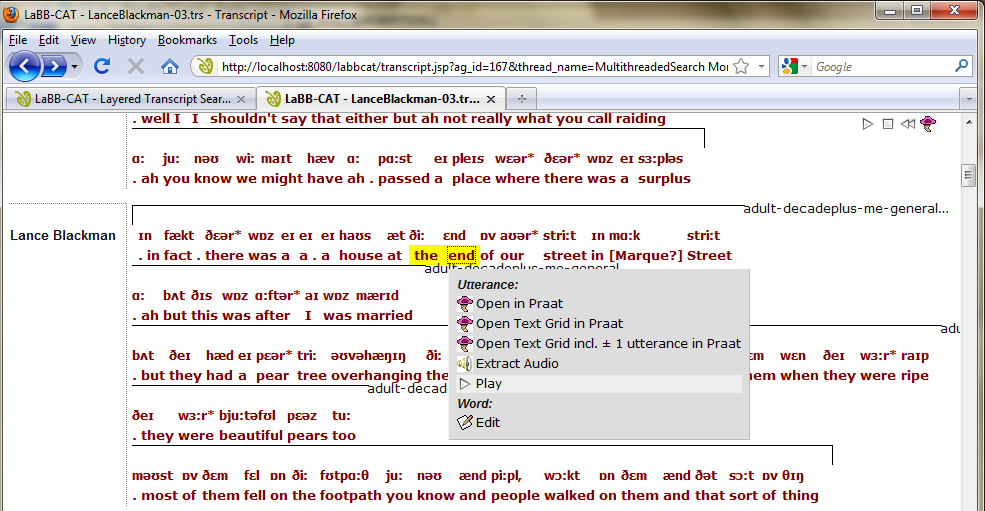https://labbcat.canterbury.ac.nz/

Please update your links to:
https://labbcat.canterbury.ac.nz/

|
LaBB-CAT is a browser-based linguistics research tool that stores audio or video recordings, text transcripts, and other annotations. Annotations of various types can be automatically generated or manually added. The transcripts and annotations can be searched for particular text or regular expressions. The search results, or entire transcripts, can be viewed or saved in a variety of formats, and the related parts of the recordings can be played or opened in acoustic analysis software, all directly through the web-browser. |
LaBB-CAT is essentially a repository for time-aligned transcripts of audio/video recordings. Time-aligned transcripts can produced using Transcriber or Praat (which can be used to create a document lining up the transcript text with the corresponding location in the audio/video recording). The transcript is then uploaded to LaBB-CAT, which allows additional information about the speakers and the transcripts to be stored.

Combining the signal data, the raw orthographic transcriptions, and some third-party data and tools, the transcripts can be automatically annotated, for example:
 With the help of data from CELEX, words can be automatically annotated with further data:
With the help of data from CELEX, words can be automatically annotated with further data:
With the help of HTK, transcripts aligned at the utterance level can be force-aligned to the word and segment level.

Word frequency data for the LaBB-CAT database itself can be computed and annotated directly on each word.

Combining time alignment information and syllable count from CELEX, speech rate can be calculated over different domains.

With help from the Stanford Parser, editable syntactic trees can be generated for the transcripts.

Annotations can be manually added, e.g.

Once transcripts and annotations are in place, searches can be performed across transcripts which meet certain criteria (e.g. based on age/gender of the speaker, corpus the transcript belongs to, etc.):

When the speakers have been selected, their utterances can be searched for text or regular expressions, across different layers:

This returns a list of all of the utterances from the selected transcripts which match the query.

If desired, this list can be exported, together with relevant speaker and annotation information, directly to a CSV file, ready for further analysis in Excel or R:

Or audio samples can be extracted for analysis:

Alternatively, clicking on an utterance returned by the search produces the full transcript for the speaker involved, positioned with the relevant utterance at the top of the screen. Any part of the transcript can be clicked on, and the corresponding part of the media played. Media can be stored on the webserver, on disk, or on CD (which is prompted for if required):

Directly from the interactive transcript page, the media can be played, other annotation layers can be displayed, the audio for the line can be extracted, or opened in Praat with a corresponding TextGrid containing annotations. Annotations can be added, edited, or removed, and alignments adjusted.
Transcriber is a free, 3rd-party software tool for creating and edited time-aligned transcripts - these are XML documents that line up transcript text with the corresponding part of the audio recording.
You can find out more about Transcriber here: http://trans.sourceforge.net

Praat is a free, 3rd-party software tool for acoustic analysis. Currently, through a web browser, LaBB-CAT is capable of interacting only with Praat.
Also, Praat can be used instead of Transcriber for creating transcripts.
You can find out more about Praat here: http://www.praat.org/
A server computer with
Because LaBB-CAT is written in Java, your server can run under Windows, Linux, or Macintosh OS X.
Any client computers that you wish to use to search the LaBB-CAT must
have:
They can run under Windows, Linux, or Macintosh OS X
To interact with Praat, they must also have Praat installed.
You may also install Transcriber to create transcripts with, or you can do transcription with Praat.
Alternatively LaBB-CAT can be used as a 'standalone' system - i.e. the 'server computer' and the 'client computer' can be the same, in which case no network access is required.
LaBB-CAT can be downloaded from here: https://sourceforge.net/projects/labbcat/files/install/.
If you do download LaBB-CAT, please drop us a line, and let us know what you are using it for, and whether the installation goes smoothly.
You may also be interested in perusing this LaBB-CAT worksheet, which talks users through the various features. It presupposes access to a particular demo corpus which you won't have access to, but may still contain useful pointers.
There is also an article outlining the architecture and construction of LaBB-CAT.
LaBB-CAT is Open Source software, published with GNU's General Public
License.
You can install and use it free of charge, and you can change and
redistribute it freely, as long as your changes are also released as Open Source
software. For more information, visit GNU: http://www.gnu.org/licenses
The system was designed and written by Robert Fromont and Jen Hay for the ONZE (Origins of
New Zealand English) Project, at the New Zealand Institute of Language, Brain and Behaviour.
The ONZE Project has a large (more than 1000 hours) corpus which contains
recordings of people born in New Zealand from the 1850s to the 1980s. The
ONZE Project was originally conceived as a project that traced the development
of the New Zealand accent. Three different types of phonetic/phonological
analyses have been carried out: auditory perceptual analyses, auditory
quantitative analyses and acoustic analyses.
Since 2003 we have been working on techniques for interacting more directly
with the sound-files, via the orthographic transcript. That is, we wanted to
introduce timestamping information into the transcript, so that a researcher
could directly access any particular utterance of interest. After an initial
exploration of appropriate tools, we settled on Transcriber
software. NXpeds Footpedals (http://www.nxpeds.com/) have been programmed
for use with the software, so that transcribing into Transcriber proceeds very
similarly to the traditional use of a transcription machine.
Because the format of the Transcriber files is XML, it can be relatively
easily transformed into other formats. We therefore developed a simple java
utility which would transform the Transcriber files into TextGrids for use with
Praat
acoustic analysis software.
This system has already radically increased the efficiency with which we can interact with the corpus. It raises exciting new possibilities for research projects that would have previously been extremely time-consuming.